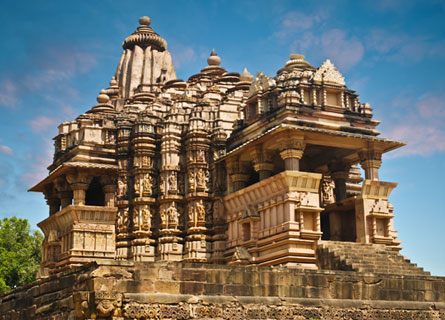
Khajuraho, the capital of the Chandela dynasty, offers visitors nearly 85 temples belonging to the main attractions of India. The temples of Khajuraho are considered the epitome of Hindu architecture and sculpture art. The best known is the Laksman Temple, dedicated to Lord Vishnu and the input of the holy trinity of Brahma, Vishnu and Mahesh is ready. Unique in India are the relief's with erotic representations of the temple facades.
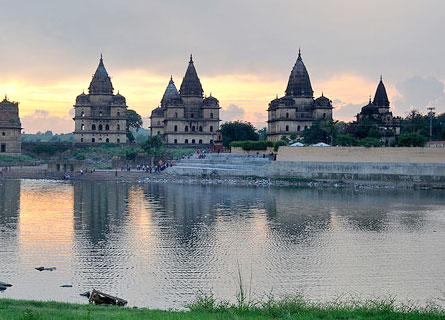
The small and medium-alterliche town on the banks of the Betwa River was the center of one of the most important Rajpu-tenreiche Central India about 450 years ago. From the heyday still stands the palace Jehangir Mahal.

Chanderi is a town of historical importance in Ashoknagar District of the state of Madhya Pradeshin India. It is situated at a distance of 127 km from Shivpuri, 37 km from Lalitpur, 55 km from Ashok Nagar and about 45 km from Isagarh. It is surrounded by hills southwest of the Betwa River. Chanderi is surrounded by hills, lakes and forests and is spotted with several monuments of theBundela Rajputs and Malwa sultans. Chanderi is located strategically on the borders of Malwa and Bundelkhand. History of Chanderi goes back to the 11th century, when it was dominated by the trade routes of Central India and was proximate to the arterial route to the ancient ports of Gujarat as well as to Malwa, Mewar, Central India and the Deccan. Consequently, Chanderi became an important military outpost. The town also finds mention in Mahabharata. Shishupal was the king of Chanderi during the Mahabharata period.
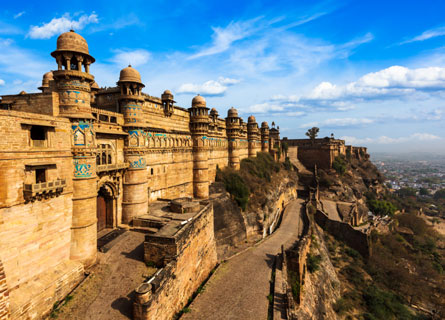
Gwalior City is a District in Madhya Pradesh State near Agra. The new section of the city called Lashkar. Lashkar is few miles South from the old city. The city is also the setting for the memorials of freedom fighters such as Tatya Tope and the indomitable Rani of Jhansi.
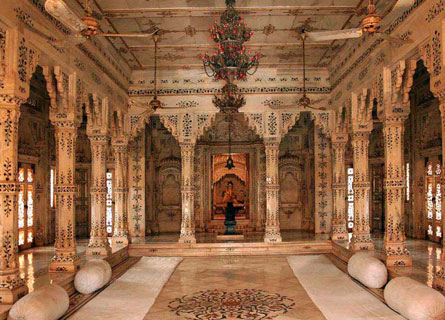
Shivpuri is an ancient town and a sacred place. It was formerly known as Sipri. It received its current name after independence in honor of the God Shiva . Shivpuri was awarded as Jagir to the Kachwahas of Narwar in the 17th century.Shivpuri king and fort was won by Ranoji Bhoite,a Maratha General of Chhatrapati of Satara on instructions of Jankoji Shinde,Gwalior Chief. Tantya Tope was awarded death sentence on 17 April 1859 by British Raj for his part in the Revolt of 1857 in nearby Jhansi. He was hanged to death in Shivpuri.

Dotted with stupas, monasteries and temples, with an incredible sense of tranquillity and peace, the little grassy knoll at Sanchi is one of the most popular Buddhist pilgrimage sites in India. Although not sanctified by a visit from the Buddha, Sanchi was where generations of Buddhist devotees, beginning with the Mauryan emperor, Ashoka, expressed their devotion in stone. Drawn perhaps by the sense of tranquillity at Sanchi, Emperor Ashoka (c.273-236BC), built a brick stupa.
Through the centuries, right up to the twelfth century, countless kings, monks and lay worshippers added temples, monasteries and votive stupas to make Sanchi one of Buddhism's greatest religious centres. Visit it on autumn evening, when the star is beginning to come out, and feel the oneness with the Buddha.

Bhimbetka with over 700 rock shelters set in its environment known for it largest rock painting complex in the country. Archaeological evidence at Bhimbetka show continuous sequence of cultures from Palaeolithic to the medieval times. Executed mainly in red and white with the occasional use of green and yellow, with theme taken from everyday events, the scenes usually depict hunting, dancing music, horse and elephant riders, animal fighting, honey collection, decoration of bodies, disguises, masking and household scenes. Animal such as bison's, tigers, lions, wild boar, elephants, antelopes, dogs, lizards, crocodiles, etc. Have been depicted in some caves. Popular religious and ritual symbols also occur frequently.

Mandu is a historic city in Malwa plateau with large number of historic monuments. Mandu, with its lakes and palaces was a pleasure resort. A testament to the love and romance between Prince Baz Bahadur and Rani Roopmati, it is situated in the Dhar district of western Madhya Pradesh and was founded in the 11th century by Parmar rulers who used it as their fort capital.
There are several palaces, baths, attractive canals and artistically crafted pavilions. The rock-cut caves with enchanting paintings decorating the walls and ceilings are added attractions.
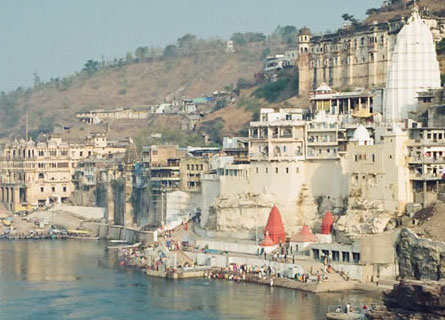
Omkareshwar is considered to be one of the holiest Hindu sites in the nation. This is due to the presence of the Jyotirlingam, one of the twelve in India. Lingam is the symbol of Lord Shiva but the Jyotirlingam is special. Jyotirlingam is called the lingam of light. the shape of the island is said to be like the Hindu ॐ symbol It is said to derive currents of power from within itself. While, an ordinary lingam is ritually invested with mantra shakti (power invested by chants) by the priests. The Jyotirlingam is enshrined in the Temple of Sri Omkareshwar Mahadeo.
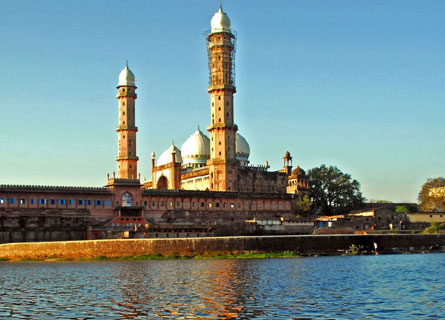
Bhopal is the capital of Madhya Pradesh. Founded by Raja Bhoj, the city has many natural and artificial lakes and it is one of the greenest cities in the country. Bhopal has retained its old world charm despite industrialization, with the old part of the city being full of narrow alleyways and crammed markets, while the new part of the city is better planned and is full of parks and gardens. The city was also the site of India's worst industrial disaster. The Bhopal Gas tragedy of 1984 claimed 2,259 lives and left several thousand permanently or partially disabled.

Indore is a fascinating city with a blend of a rich cultural and historical heritage hosting a wide range of styles of the Maratha, Mughal, Holkar and British era. Chhatris, Laal Bag Palace, Kanch Mandir are cues of its architectural excellence. Situated on one of India's oldest pilgrimage routes from Mahakaal at Ujjain on river Kshipra, to Omkareshwar on the river Narmada and onwards to Rameshwaram, Indore is embellished by several forts and rocky shrines: Mandu, Dewas, Maheshwar, Omkareshwar being the prominent ones.
One of the most legendary rulers of Indian history, Devi Ahilyabai Holkar is the patron of many traditional architecture here. Apart from these, the rustic spirit of Chokhi and Nakhrali Dhani, heritage resorts on the outskirts of Indore filled with varied traditional Rajasthani delicacies adds a Rajasthani flavour to the city.
Pachmarhi is a hill station of Madhya Pradesh situated on a large plateau Mahadeo hills of Satpura ranges. It is widely known as "Queen of Satpura". Pachmarhi lies in Hoshangabad district of among all tourist spots of Madhya Pradesh, Pachmarhi is the most favorite tourist spot among domestic tourists of India.
Pachmarhi is discovered by British Army Captain - James Forsyth in 1857 and wrote book on Pachmarhi called "The Highlands of Central India". Dense forests and its in-accessibility for normal person had made it a safe place for hideout for freedom fighters like Rani Jhansi, Tatya Topa etc. Presence of 5 ancient caves had made it famous with the name of Pachmarhi where "Panch" means five and "Marhi" means caves. Its scenic beauty and climate had made it popular among britishers during pre-independence era in summer season.

Satpura National Park is located in district Hoshangabad of Madhya Pradesh in Central India. It gets the name from Satpura hill ranges (Mahadeo hills). It covers an area of 524 km2. Satpura National Park, and along with the adjoining Bori and Panchmarhi Sanctuaries, provides 1427 km2 of unique Central Indian Highland ecosystem. It was set up in 1981. The terrain of the national park is extremely rugged and consists of sandstone peaks, narrow gorges, ravines and dense forests. The altitude ranges from 300 m to 1352 m. It has Dhoopgarh peak as high as 4500 feet (1400 m) and the almost level plains of Churna.
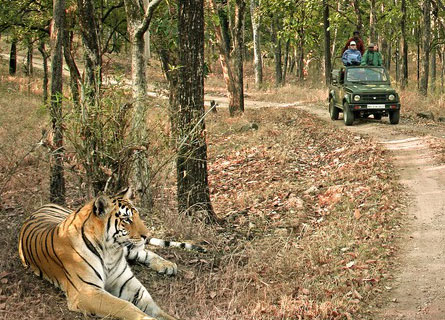
Pench National park, nestling in the lower southern reaches of the satpuda hills is named after Pench river, meandering through the park from north to south. It is located on the southern boundary of Madhya Pradesh, bordering Maharashtra, in the districts of Seoni and Chhindwara. Pench National Park, comprising of 758 SQ Kms, out of which a core area of 299 sq km of Indira Priyadarshini Pench National Park and the Mowgli Pench Sanctuary and remaining 464 sq km of pench national park.
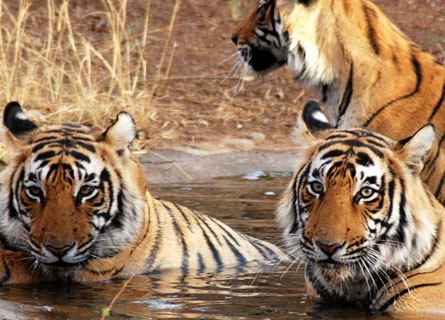
Located in the Mandla district of Madhya Pradesh, Kanha national park cum Tiger reserve extends over an area of over 1,940 sq kms. The major feature of this region's interesting topography is the horseshoe shape valley and the whole park area is surrounded by the spurs of the Mekal. The Surpan River meanders through Kanha's central Maidans, grasslands that cover the extensive plateau. Steep rocky escarpments along the edges offer breathtaking views of the valley.
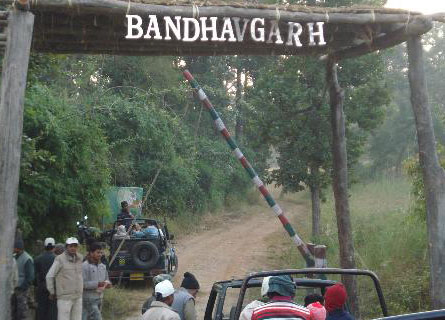
Bandhavgarh is spread at vindhya hills in Madhya Pradesh. Bandhavgarh consists of a core area of 105 sq km and a buffer area of approximately 400 sq km of topography varies between steep ridges, undulating, forest and open meadows. Bandhavgarh is known for the Royal Bengal Tigers the density of the Tiger population at Bandhavgarh is the highest known in India.
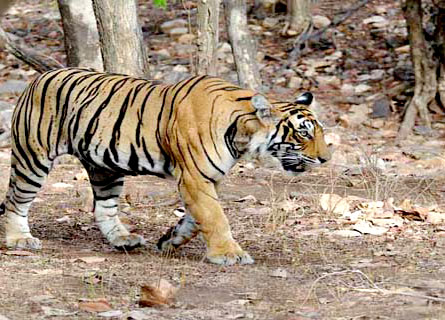
Panna is located in the central Indian state of Madhya Pradesh. The river Ken passes through the park, adding to its scenic beauty. Panna Wildlife Sanctuary was created in year 1981 and was declared a Project Tiger Reserve by Government of India in year 1994. The region, which is famous for its diamonds, is also home to some of the best wildlife species in India and is one of the better Tiger Reserves in the country.
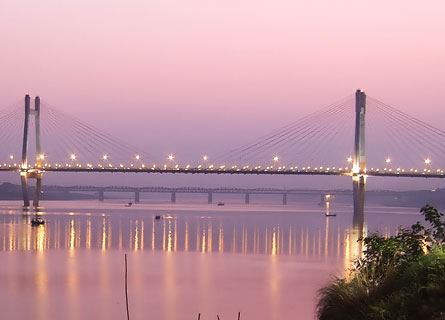
The city of Allahabad is among the largest cities of Uttar Pradesh and situated at the confluence of three rivers - Ganga, Yamuna and the invisible Saraswati. The meeting point is known as Triveni and is especially sacred to Hindus. The earlier settlements of the Aryans were established in this city, then known as Prayag Prayagasya Praveshshu Papam Nashwati Tatkshanam. All sins are cleaned with entry in Prayag ( the ancient name of modern time Allahabad) PRAYAG is one of the historic and mythological cities of India with glorious past and present. It continues to enjoy the distinction of being a place of haunting and lasting memories. It is a city of mixed culture of Hindu, Muslims, Jains and Christians.
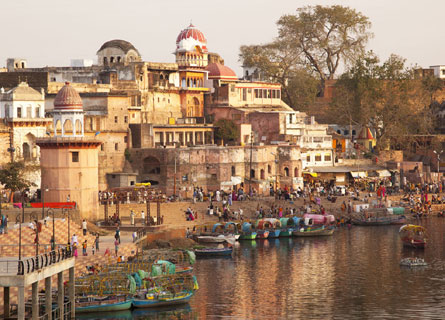
Chitrakoot means the 'Hill of many wonders'. Chitrakoot falls in the northern Vindhya range of mountains spread Chitrakoot's spiritual legacy stretches back to legendary ages: It was in these deep forests that Ram, Sita and his brother Lakshman spent eleven and half years of their fourteen years of exile; the great sage Atri, Sati Anusuya, Dattatreya, Maharshi Markandeya, Sarbhanga, Sutikshna and various other sages, seers, devotees and thinkers meditated; and here the principal trinity of the Hindu pantheon, Brahma, Vishnu and Shiva, took their incarnations

The land of Varanasi (Kashi) has been the ultimate pilgrimage spot for Hindus for ages. Often referred to as Benares, Varanasi is the oldest living city in the world. These few lines by Mark Twain say it all: "Benaras is older than history, older than tradition, older even than legend and looks twice as old as all of them put together". Hindus believe that one who is graced to die on the land of Varanasi would attain salvation and freedom from the cycle of birth and re-birth. Abode of Lord Shiva and Parvati, the origins of Varanasi are yet unknown. Ganges in Varanasi is believed to have the power to wash away the sins of mortals.

According to a legend, Vishnu was carrying a Kumbh (pot) of amrita (nectar), when a scuffle broke out the between the goods, and four drops were spilled. They felled to earth at the four tirthas of Prayag, Haridwar, Nasik and Ujjain. The event is commemorated every twelve year by the Kumbh Mela, held at each tirthas in turn; the Sangam is the referred to as Tirtharaja, the 'King of Pilgrimages' , and its Mela once every twelve years, is the holiest of all.
The Maha Kumbh Mela is the largest religious fair in India attended by millions of pilgrims. The Mela is renowned for the presence of an extraordinary array of religious ascetics - sadhus and mahants - enticed from remote hideaways in forests, mountains and caves. Once astrologers have determined the propitious bathing time or 'kumbhayog', the first to hit the water are legions of Naga sadhus or Naga babas, the ferocious looking member of the snake sect who cover their necked bodies with ash, and wear hare in long dreadlocks. The sadhus, who see themselves as guardians of the faith, approach the confluence at the appointed time with all the pomp and bravado of a charging army.
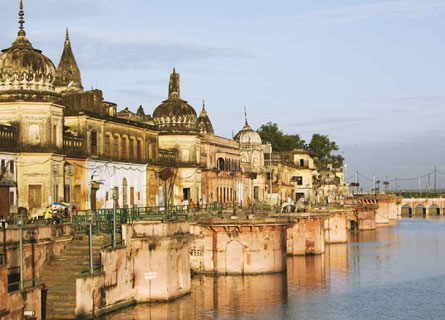
Ayodhya is today mainly a temple town. Famous for its close association with the epic Ramayana. It is a city of immense antiquity full of historical significance. all places of worship here, are not only of Hindu religion. At Ayodhya several religions have grown and prospered simultaneously and also at different periods of time in the past. Remnants of Hinduism, Buddhism, Jainism and Islam can still be found in Ayodhya.
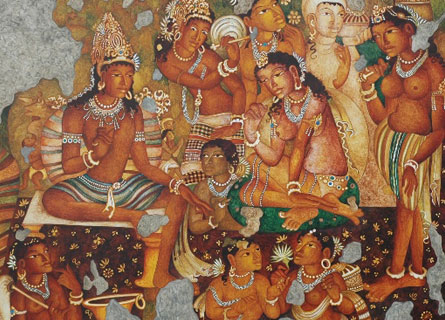
Ajanta is world's greatest historical monument recognised by UNESCO located just 55kms from Jalgaon city and 105kms from Aurangabad City of Maharashtra, India. There are 30 caves in Ajanta of which 9, 10, 19, 26 and 29 are chaitya-grihas and the rest are monasteries. These caves were discovered in AD 1819 and were built up in the earlier 2nd century BC-AD. Most of the paintings in Ajanta are right from 2nd century BC-AD and some of them about the fifth century AD and continued for the next two centuries. All paintings shows heavy religious influence and centre around Buddha, Bodhisattvas, incidents from the life of Buddha and the Jatakas. The paintings are executed on a ground of mud-plaster in the tempera technique.

About 30 km from Aurangabad are the world renowned Ellora Caves, known for their Buddhist, Jain and Hindu cultural influences. There are 34 caves containing shrines, monasteries and temples. The Buddhist caves were carved during the period 200 BC to 600 AD. These were followed by the Hindu cave (500-900 AD) and finally the Jain caves (800- 1000 AD)